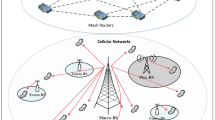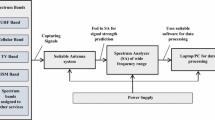Abstract
A heterogeneous cloud radio access network with low power nodes has emerged as an attractive cost-effective solution to the problem of enormous growth in data over the cellular network. Ever-increasing low power nodes such as femtocells in macrocell’s coverage area for indoor communication cause severe cross-tier interference to the umbrella macrocell network. One of the promising paradigms to avoid this interference is cognitive radio-enabled heterogeneous cloud radio access network architecture. In this paper, two mechanisms, channel sensing and channel negotiation, for allocating channels to femtocell users have been proposed suitable for this architecture. After identifying an idle slot by channel sensing, a femtocell user requests the base station pool for free channel suggestions and senses the listed channels later. Femtocell user equipment does not wait for the next slot to sense another channel on identifying an occupied channel in a slot. Two and three types of error in sensing and negotiation, respectively, have been defined. Poisson traffic model is developed for generating macrouser traffic. Throughput has been analyzed by varying macrouser arrival rate, the number of femtocell users, the average service time of macrouser, and sensing time considering the errors in sensing and negotiation mechanisms. Simulation results have shown that the maximum throughput for error-free sensing and negotiation in case of low macrouser traffic is 27 Mbps. A difference of 10 Mbps between maximum throughput without any error and throughput with sensing and negotiation errors is also observed.
Access this chapter
Tax calculation will be finalised at checkout
Purchases are for personal use only
Similar content being viewed by others
References
Peng M, Li Y, Zhao Z, Wang C (2015) System architecture and key technologies for 5G heterogeneous cloud radio access networks. IEEE Netw 29:6–14. https://doi.org/10.1109/MNET.2015.7064897
Peng M, Sun Y, Li X, Mao Z, Wang C (2016) Recent advances in cloud radio access networks: system architectures, key techniques, and open issues. IEEE Commun Surv Tutorials 18:2282–2308. https://doi.org/10.1109/comst.2016.2548658
Al-Turjman F, Ever E, Zahmatkesh H (2019) Small cells in the forthcoming 5G/IoT: traffic modelling and deployment overview. IEEE Commun Surv Tutorials 21:28–65. https://doi.org/10.1109/COMST.2018.2864779
Zhang H, Jiang C, Cheng J, Leung V (2015) Cooperative interference mitigation and handover management for heterogeneous cloud small cell networks. IEEE Wirel Commun 22:92–99. https://doi.org/10.1109/MWC.2015.7143331
Tang Y, Yang P, Wu W, Mark J (2019) Cooperation-Based interference mitigation in heterogeneous cloud radio access networks. In: ICC 2019—2019 IEEE international conference on communications (ICC). IEEE, Shanghai, pp 1–6. https://doi.org/10.1109/ICC.2019.8761280
Peng M, Li Y, Jiang J, Li J, Wang C (2014) Heterogeneous cloud radio access networks: a new perspective for enhancing spectral and energy efficiencies. IEEE Wirel Commun 21:126–135. https://doi.org/10.1109/mwc.2014.7000980
Budhiraja I, Tyagi S, Tanwar S, Kumar N, Guizani M (2018) CR-NOMA based interference mitigation scheme for 5G femtocells users. In: 2018 IEEE global communications conference (GLOBECOM). IEEE, Abu Dhabi, pp 1–6. https://doi.org/10.1109/GLOCOM.2018.8647354
Qamar F, Hindia M, Dimyati K, Noordin K, Amiri I (2019) Interference management issues for the future 5G network: a review. Telecommun Syst 71:627–643. https://doi.org/10.1007/s11235-019-00578-4
Sahu G, Pawar S (2020) An approach to reduce interference using FFR in heterogeneous network. SN Comput Sci 1. https://doi.org/10.1007/s42979-020-0092-y
Ghosh J, Jayakody D, Qaraqe M (2018) Downlink capacity of OFDMA-CR based 5G femtocell networks. Phys Commun 29:329–335. https://doi.org/10.1016/j.phycom.2018.04.016
Meerja K, Shami A, Refaey A (2015) Hailing cloud empowered radio access networks. IEEE Wirel Commun 22:122–129. https://doi.org/10.1109/MWC.2015.7054727
Meerja K, Ho P, Wu B, Yu H (2013) Media access protocol for a coexisting cognitive femtocell network. Comput Netw 57:2961–2975. https://doi.org/10.1016/j.comnet.2013.06.017
Zhang H, Jiang C, Mao X, Chen H (2016) Interference-Limited resource optimization in cognitive femtocells with fairness and imperfect spectrum sensing. IEEE Trans Veh Technol 65:1761–1771. https://doi.org/10.1109/TVT.2015.2405538
Kumar A, Thakur P, Pandit S, Singh G (2019) Analysis of optimal threshold selection for spectrum sensing in a cognitive radio network: an energy detection approach. Wireless Netw 25:3917–3931. https://doi.org/10.1007/s11276-018-01927-y
Zhang H, Nie Y, Cheng J, Leung V, Nallanathan A (2017) Sensing time optimization and power control for energy efficient cognitive small cell with imperfect hybrid spectrum sensing. IEEE Trans Wireless Commun 16:730–743. https://doi.org/10.1109/TWC.2016.2628821
Wang W, Yang H (2018) Effect of imperfect spectrum sensing on slotted secondary transmission: energy efficiency and queuing performance. IEEE Trans Cognitive Commun Networking 4:764–772. https://doi.org/10.1109/TCCN.2018.2874457
Ghasemi A, Sousa, ES (2005) Collaborative spectrum sensing for opportunistic access in fading environments. In: First IEEE international symposium on new frontiers in dynamic spectrum access networks. DySPAN 2005. IEEE, Baltimore, pp. 131–136. https://doi.org/10.1109/DYSPAN.2005.1542627
Author information
Authors and Affiliations
Corresponding author
Editor information
Editors and Affiliations
Rights and permissions
Copyright information
© 2022 The Author(s), under exclusive license to Springer Nature Singapore Pte Ltd.
About this paper
Cite this paper
Das, A., Asaduzzaman, Dey, A. (2022). Analyzing the Errors in Channel Sensing and Negotiation in Cognitive Radio H-CRAN. In: Patgiri, R., Bandyopadhyay, S., Borah, M.D., Emilia Balas, V. (eds) Edge Analytics. Lecture Notes in Electrical Engineering, vol 869. Springer, Singapore. https://doi.org/10.1007/978-981-19-0019-8_33
Download citation
DOI: https://doi.org/10.1007/978-981-19-0019-8_33
Published:
Publisher Name: Springer, Singapore
Print ISBN: 978-981-19-0018-1
Online ISBN: 978-981-19-0019-8
eBook Packages: EngineeringEngineering (R0)




